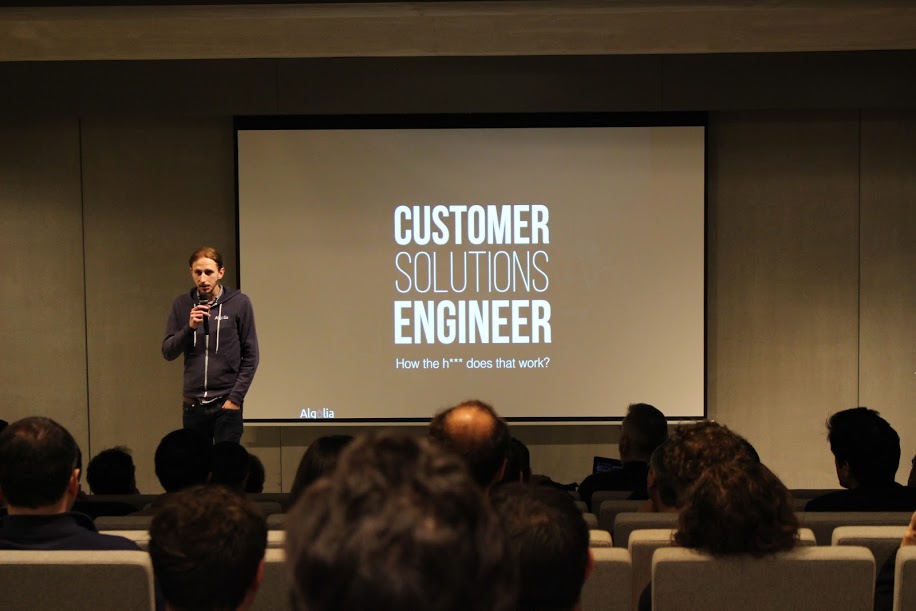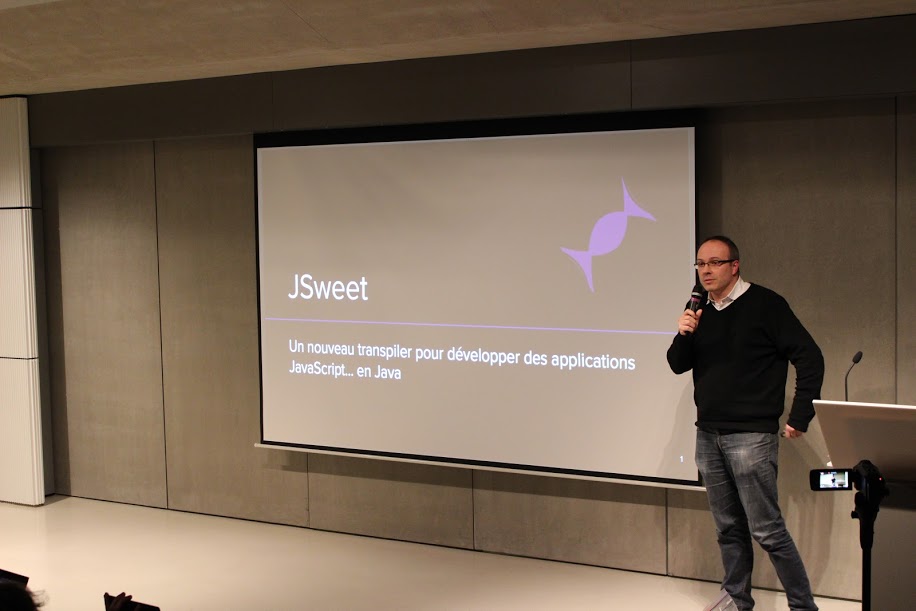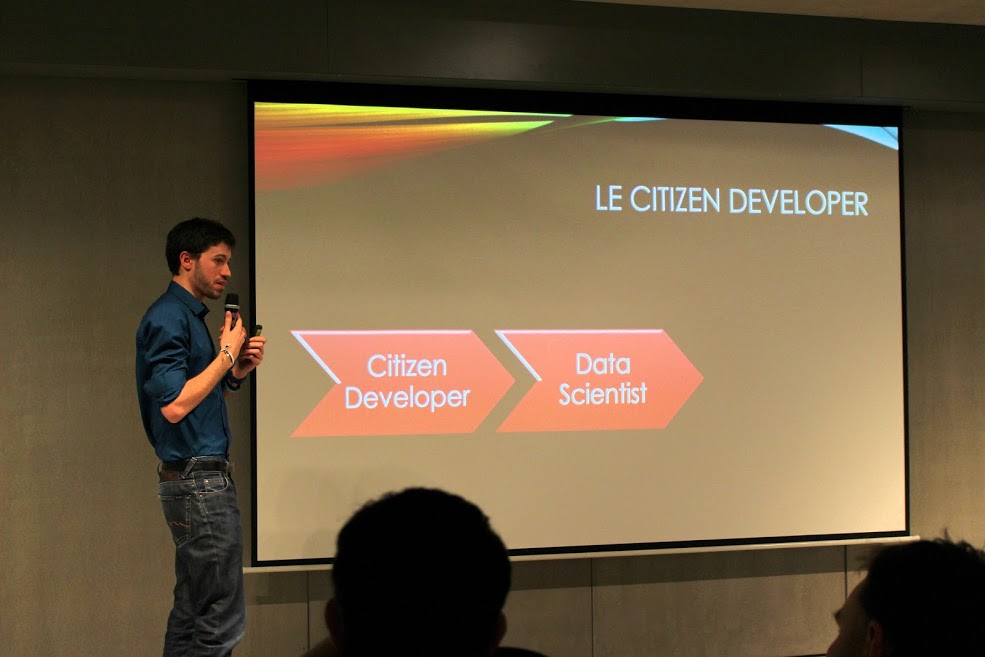HumanTalks February 2016
09 Feb 2016This month's HumanTalks was hosted by Criteo. We had a hard time managing to correctly plug the laptops in to the projector and connect to the wifi so we started a bit late. This forced us to cut down the questions from 10mn to only 6 or 7.

Customer Solutions Engineer
The first talk was by Nicolas Baissas, my coworker at Algolia. He explained what the job of CSE really means. The job originated mostly in the Silicon Valley for SaaS companies, but is moving to all sort of companies.
The goal of a CSE is to make the customers successful, by making them happy to use the product, for the longest amount of time. This is especially important for SaaS companies where revenue is based on a monthly payment. You do not want your customers to leave your service, and the best way to keep them is to offer them a better and better service.

There will always be customers leaving, which is what is called a churn, but the goal of a CSE is to make sure the company has a negative churn. This means that the customers that stay compensate for those who left, because they now use more of the service than before. The CSE must ensure that less and less customers want to leave, by understanding what they are looking for while managing to bring more and more value of the product to the already happy customers.
The only way to do that is to try to be part on their team, showing that you're on their side, and not trying to push selling more and more. CSE are experts on their product, and they share that expertise with the customers by email, by Skype or whenever possible, by meeting them directly. This also happens before, during and after Algolia's deployment in their system. The CSE ensures that they use the service at its best, and that it is used in the best way possible to fit their needs.
Month after month, they have a regular look at all the past implementations of their customers and reach out with advices if they see things that could be improved. Today Algolia has more than 1000 customers but only 4 CSEs, so this has trouble scaling. So in parallel they also work on making it easy for all the customers they do not have time to talk to.
They write guides, explaining specific features in detail, with examples. They have already explained the same thing hundreds of times on calls, so they have experience on how to explain it clearly, then it's just a matter of writing it down. They also write detailed tech tutorials. They all have a tech background and know how to code, so they can really understand what it requires to implement Algolia in an existing system.
The goal is to automate most of the recurring work. They built a new tab in the UI to analyze the current configuration of a customer and suggest improvements. Those are the exact same improvements than they would have suggested during a one-to-one call, but because they have the experience and know how to code, they can just simply make it self-service for users directly.
Some of the features are too complex to be correctly grasped just by reading the theory, like geosearch. So they created a demo with real data, using all the best practices and letting users play with it to see how it was working. This worked really well and transformed a theoretical feature into a real life application and in turn generated signups to the service.
What Nicolas really stressed out is that the role of a CSE is to be as close to the customer as possible, in order to really understand, in a real-life scenario, what he wants to do, with the very specifics of its project. But as well be as close as possible to the product itself, part of the team that builds it so he can exactly know which features are ready and how they work. By doing both you can really bring your deep expertise of the service to the specific issues of the customer while helping build the service with real-life examples of real-life issues customers have.
A CSE's ultimate goal is to not be needed anymore, the documentation and self-service information should be enough for most of the users, and core developers of the service should be in direct contact with the users so they know how people really use their service.
JSweet
The second talk was about JSweet, a transpiler of Java to JavaScript. A transpiler is like a compiler, it transforms a language into another language, or even the same. There are Java-to-Java transpilers, that can refactor the code and there are already a lot of tools transpiling to JavaScript (e.g. CoffeeScript, Dart and TypeScript).

Of these three, TypeScript seems to be the most popular today. It was originally created by Microsoft, but then Google started using it for Angular. TypeScript mostly adds a typed layer on top of JavaScript, but still lets you use vanilla JavaScript wherever you want.
There already were attempts at a Java-to-JavaScript transpiler in the past, namely with GWT, but it was not as promising as announced and carried many organic limitations. GWT is too much of a blackbox, and you couldn't use the generated JavaScript with regular JS APIs, so that it was quickly outdated and the promise of having all Java in JavaScript wasn't even fulfilled. Mostly, it was done for developers that did not want to learn JavaScript and just wanted their backend code to work in the frontend as well.
Later on, we saw the emergence of NodeJS, where one of the cool features was that you could use the same language on the backend and frontend. NodeJS being written in JavaScript, it meant that you had to ditch your old Java/Ruby/PHP backend and put NodeJS instead. JSweet follows the same logic of "same language" everywhere, but this time it lets you use JavaScript with the Java language.
TypeScript syntax being really close to Java, it is easy to transpile from one to the other. Then, TypeScript transpiling to JavaScript, you can transpile all the way from Java to JavaScript.
This lets you use all your JavaScript libraries (like underscore, moment, etc) directly in your Java code. And you can also write your frontend code with Java, letting you follow the paradigm of "one language everywhere". Internally your Java code will be transpiled to TypeScript, then to JavaScript. Not all of Java will be available in JSweet, though.
I never coded in Java so I am unsure how useful this really is, but it seemed like a nice project if you want to keep the same language from back to front.
Shadow IT
Next talk was about what is called the Shadow IT, by Lucas Girardin. The shadow IT encompass all the IT devices in a company that are invisible to the radar of the official IT departement. It includes all the employees cell phones that are used to check personal emails during the day, all the quantified self devices (FitBit, etc), Excel files filled with custom macros, personal dropbox account and even the external contracts with freelancers that are not approved by the IT department.

Granted, this kind of issues only occur in big companies, where there are way too many layers between the real needs of employees and the top hierarchy trying to "rationalize" things. This talk gave a great echo to the first talk about CSE and reminded me why I quit consulting ;).
Anyway, the talk was still interesting. It started by explaining why these kinds of shadow developments appeared in the first place: mainly because the tools the employees have were not powerful enough to let them do their job in the best environment. And because employees are getting more and more tech-savvy, they found their own ways to bypass the restrictions. They expect to have the same level of features in their day job than at home or on their smartphone. If their company cannot provide it, they will find other ways.
Unfortunately, these ways are frowned upon by the IT departement. Maybe the Excel sheet the employee is creating is really useful, but maybe it is also illegal in regard to personal information storage. Or it will break as soon as the Excel version is changed, or be completely lost when the employee leave and no backup exists.
Then I started getting lost in the talk. Some of the concepts he talked about were too alien to what I experience everyday that I had trouble understanding what it was really about. In the end he suggested a way to still rationalize those various independant parts, by building a Platform that lets users build their own tools, even if they do not know how to code. This platform would get its data from a Referential that is accessible company-wide and hold the only real trustable source of data. And finally, the IT departement will build Middlewares that will help application A to communicate with application B.
In the end, the IT department will stop building custom applications for their employees, but simply provide the tools to help them build it themselves. Still, it will have to create the middlewares to let all those parts discuss.
I cannot help but think that this does not fix the initial issue but simply gives the IT department the feeling that it is in control again. As soon as the platform tools will be too limited for employees to really do what they want (this will happen really quickly), they will revert to using other, more powerful, tools and this will still be out of the IT departement reach. I fail to see how this is any different from what it was before, except that instead of building the application themselves, the IT departement now builds the tools so the employees can build the applications, but they are still needed to make them work together and will still be a bottleneck.
You can find the slides here
Criteo Hero Team
The last talk was presented by Michel Nguyen and was about the Criteo Hero Team.
Michel told us about his team, the Hero team, for Escalation, Release and Ops. He added a H in front of it to make it cooler. The team is in charge of all prod releases as well as dealing with incidents.

They realized that whenever they put something in production, something else breaks. So they started coordinating the releases and having all the people that could understand the infra in the same team, to better understand where this could break.
The now use a 24/7 "follow the sun" schedule where teams in France and the US are always awake to follow the potential issues. They have an escalation system with two layers, that lets them deal with the minor issues without creating a bottleneck for the major ones. The Hero team is in charge of finding the root causes of the issues and if none can be found quickly enough, they will just find a temporary workaround and dig deeper later. Once the issue is found and fixed, they do a postmortem to share with everybody what went wrong, how they fixed it, and ways to prevent it from happening again.
They use Centreon and Nagios as part of their monitoring and check after each production release the state of the metrics they are following, to see if nothing extremely abnormal appeared. If too many metrics changed too widely, then we can assume something is not working correctly.
The current production environment of Criteo is about 15.000 servers, which weigh as much as 6 Airbuses and would be twice the height of the Empire State Building. They handle about ~1200 incidents per year and resolve about 90% of them in escalation. The last 10% are incidents that depends from third-parties, or one-shot incidents they never understood.
To be honest, even if the talk was interesting (and Michel is a very good speaker), it felt too much like a vanity metrics contest. I know Michel had to cut his talk from 30mn to 10mn in order to fit in the HumanTalks format, so I'd like to see the full version of it.
Conclusion
I did not felt like I was the target of the talks this time. I already knew everything about the CSE job because I work with them everyday, I never coded in Java, stopped working in companies big enough to have a Shadow IT issue and as I said, the last one left me hungry for more.
Still, nice talks and nice chats afterwards. Except for the small hiccup with the projector and wifi at the start, the room was perfect and very comfortable and the pizza + sushi buffet was great.
Next month we'll be at Viadeo. Hope to see you there!
Want to add something ? Feel free to get in touch on Twitter : @pixelastic